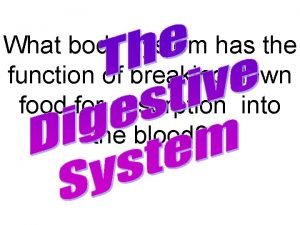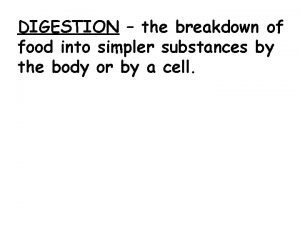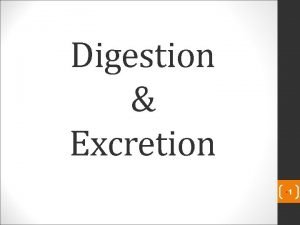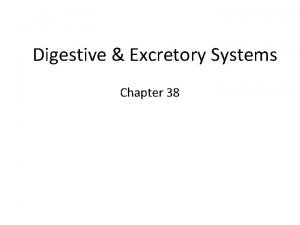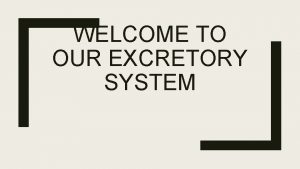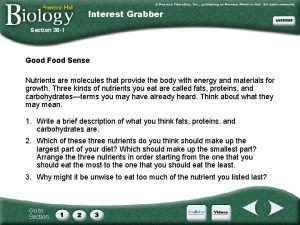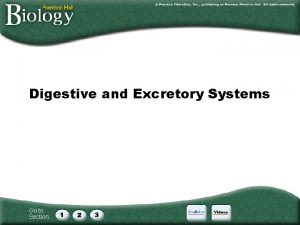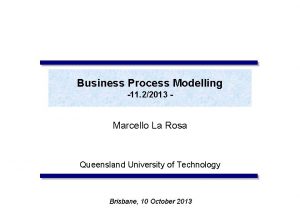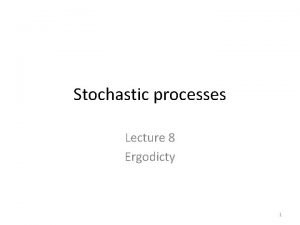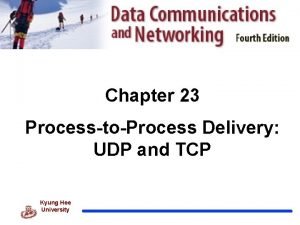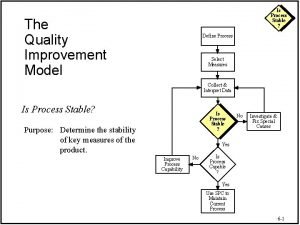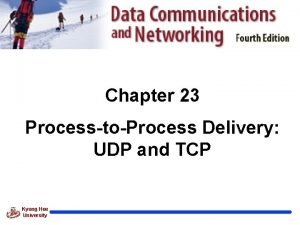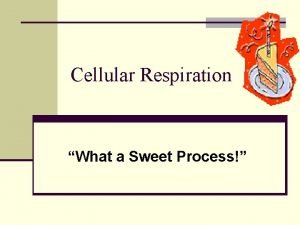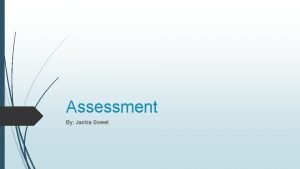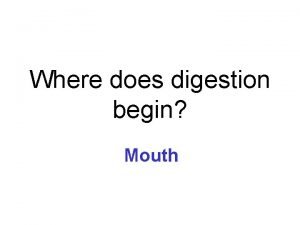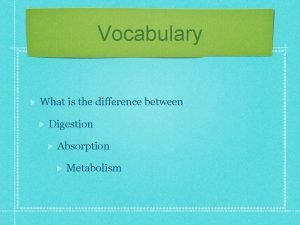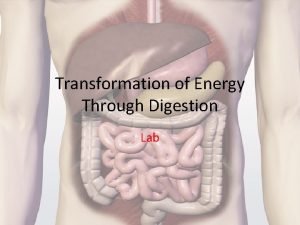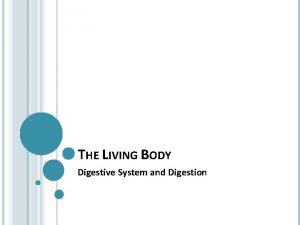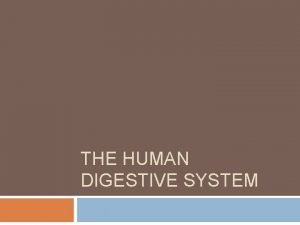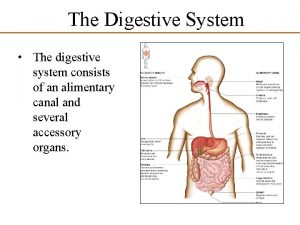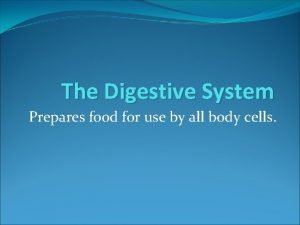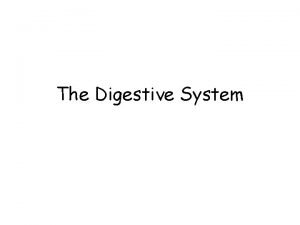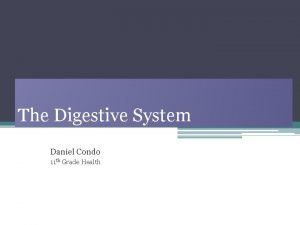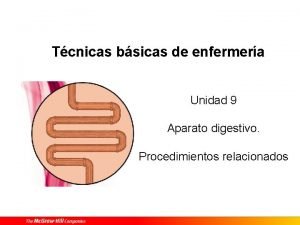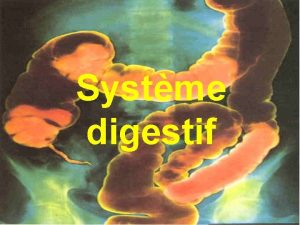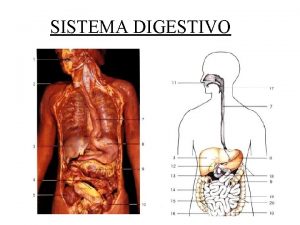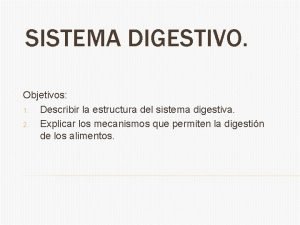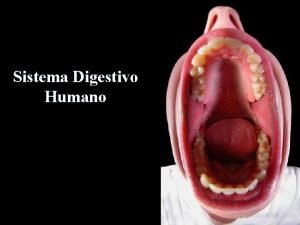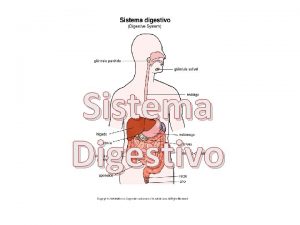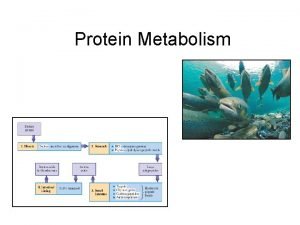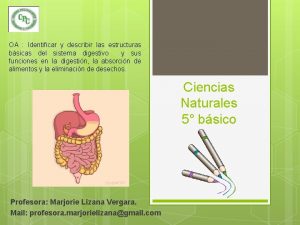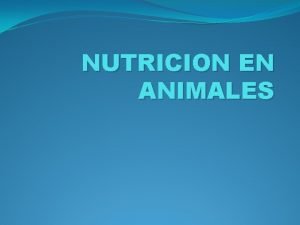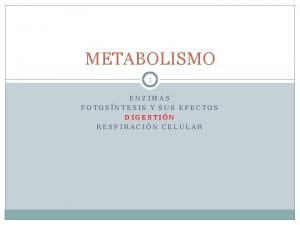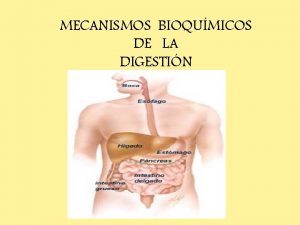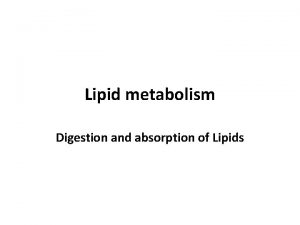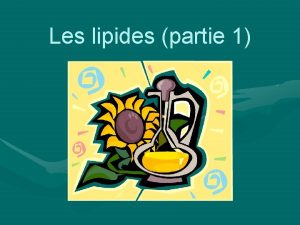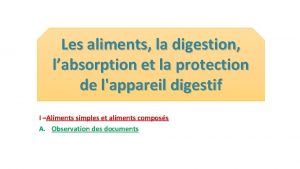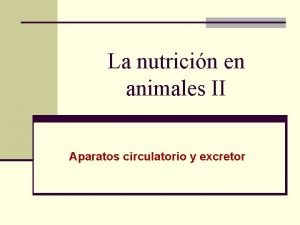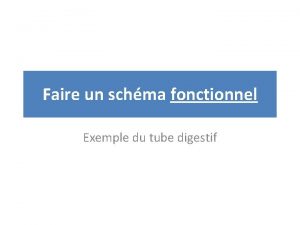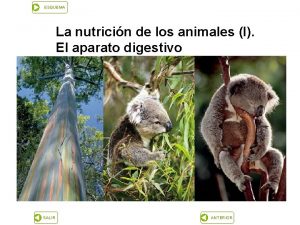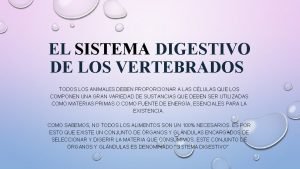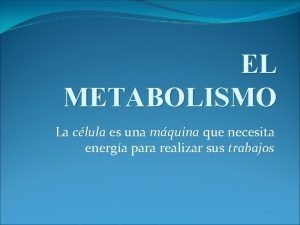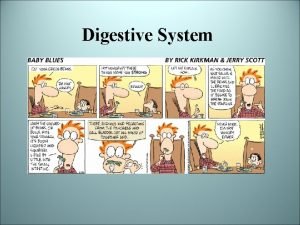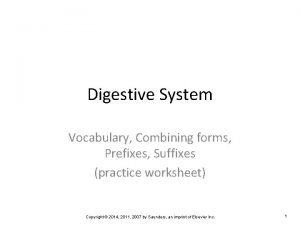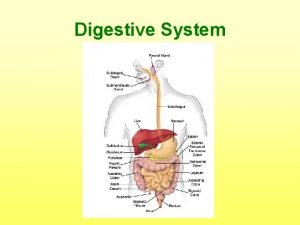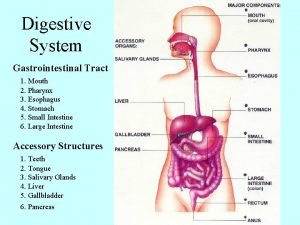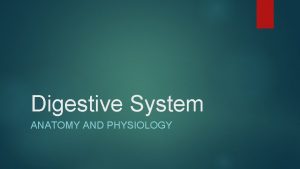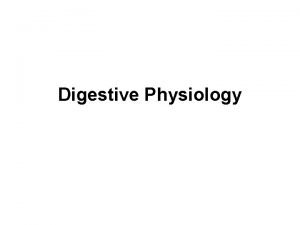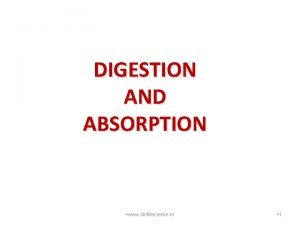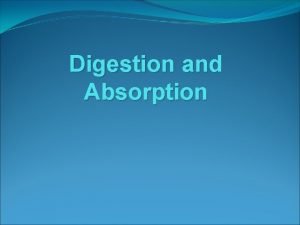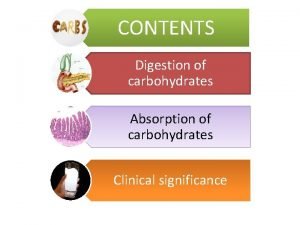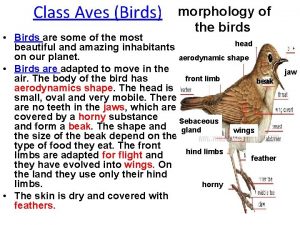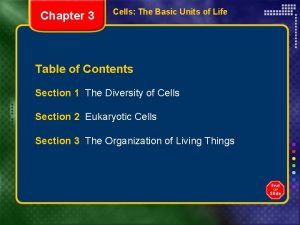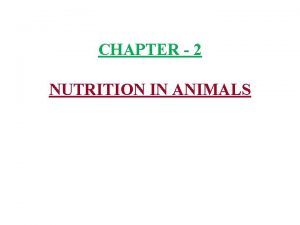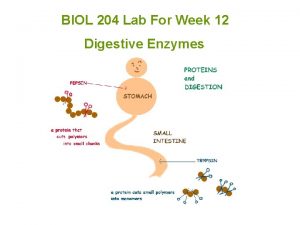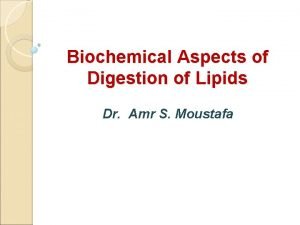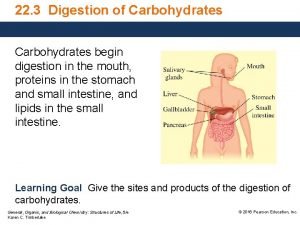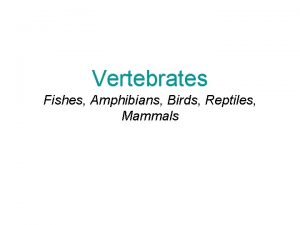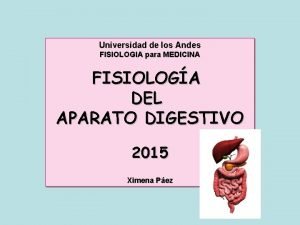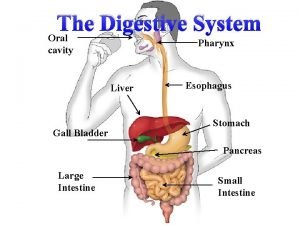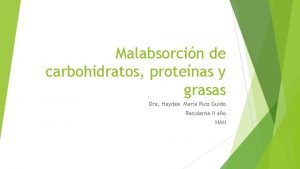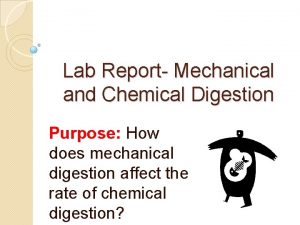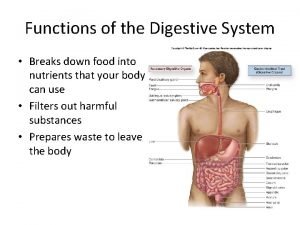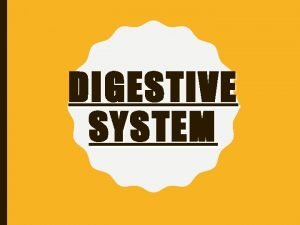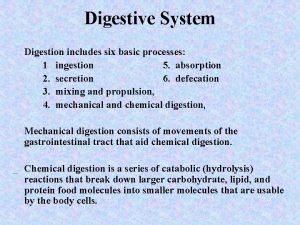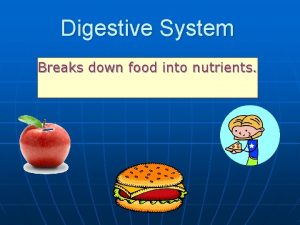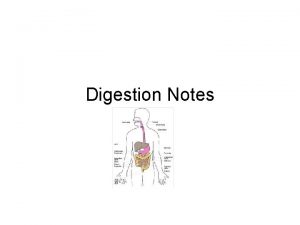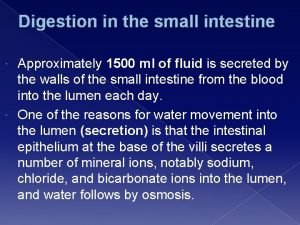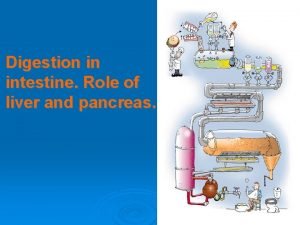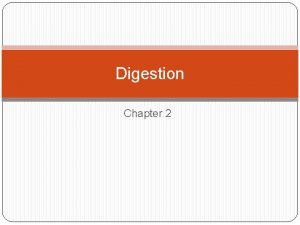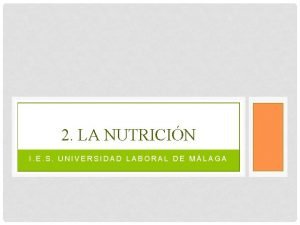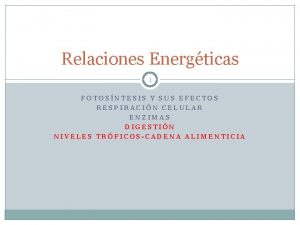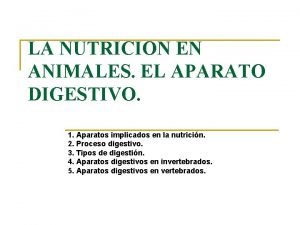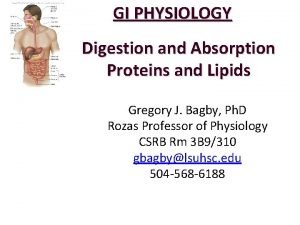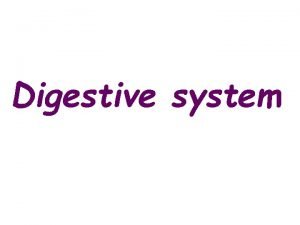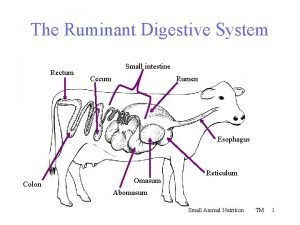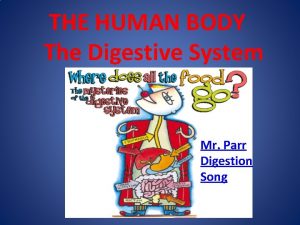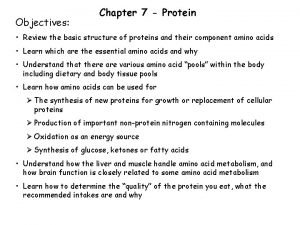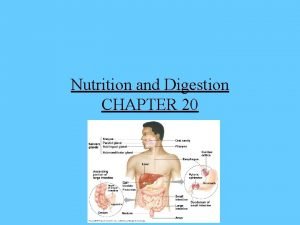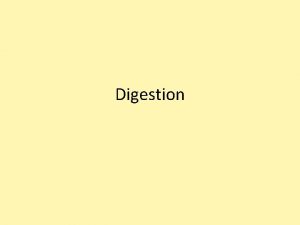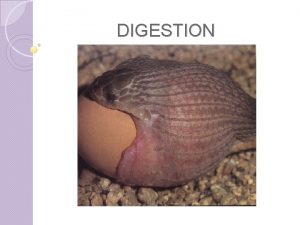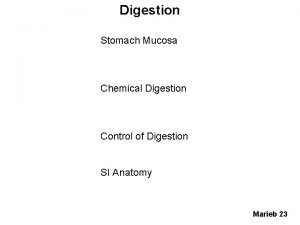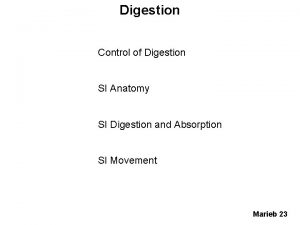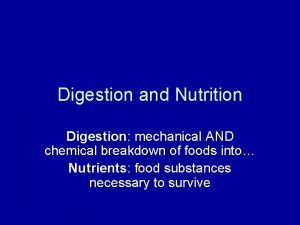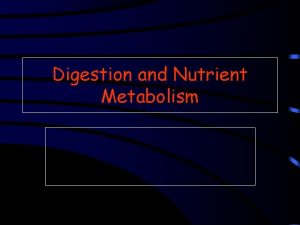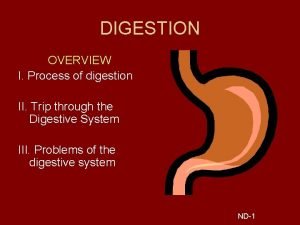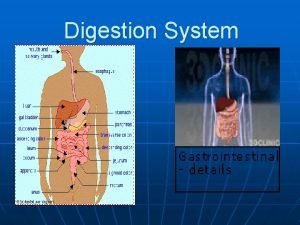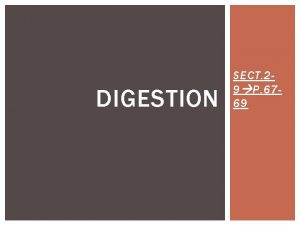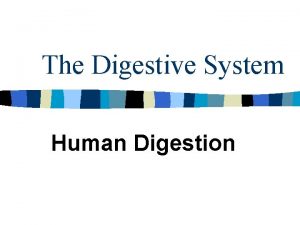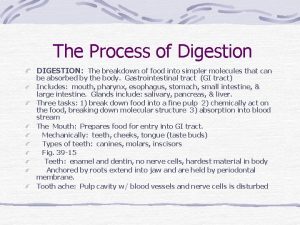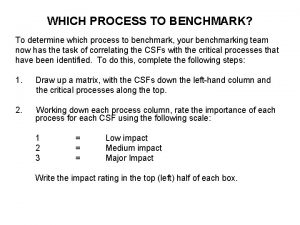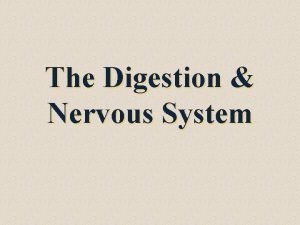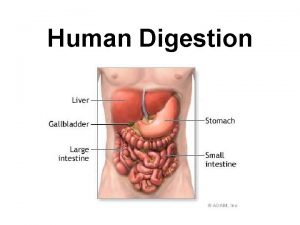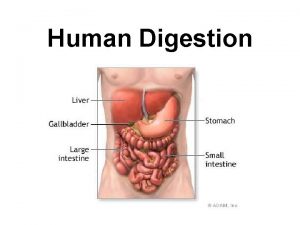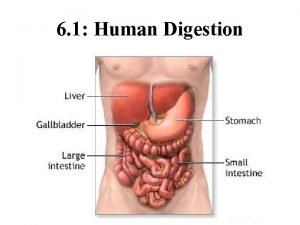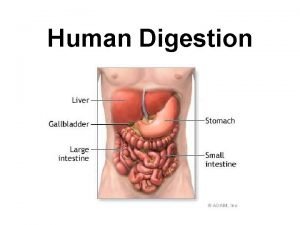DIGESTION What is digestion The process in which













































































































































- Slides: 141

DIGESTION

What is digestion? �The process in which food is broken down into smaller molecules that can be absorbed into the body and are usable by cells.

Five Main Digestive Processes 1. Ingestion – Eat; Intaking of food into 2. 3. 4. 5. Digestive Tract Movement – Food travels down digestive tract. Digestion – Large molecules Small molecules (mechanical or chemical). Absorption – Transporting digested nutrients to cells in the body. Egestion – Removal of materials (waste) from food that the body cannot digest.

Do you taste different components of taste with different parts of your tongue? The “Taste Map”: All Wrong

Tongue Papillae Circumvallate papillae

� You Taste Test! will be tasting flavoured candies. Yummy � Catch! – You have to PLUG YOUR NOSE! � One student = facilitator, other = taster � Facilitator chooses 1 candy (don’t show the taster!), unwrap it while the taster has their eyes closed and put it in their hands. � 60 seconds (keep your nose plugged!) – describe sensations and try to determine the flavour of the candy. Guess again after the min is up. THEN unplug your nose. . . Switch roles and repeat. **Remember keep the flavour a secret until the end**

Taste �What is the difference between taste and flavour? �Does smell affect taste? �If your sense of taste is impaired, it is possible your appetite might decrease. �What things might decrease your sense of taste? ◦ Cigarettes, illness, medications, vitamin

Why do we eat? ?

Nutrients! �Body needs energy to do work. �Nutrients include ◦ Carbohydrates �Provide energy (growth, warmth, movement). ◦ Proteins �For growth of cells and tissues. �Repair of damaged tissues. �Source of energy if carbohydrates and fats unavailable.

Nutrients cont… ◦ Fats �Provide energy �Two times that of carbohydrates �Nutrients help ◦ ◦ in our growth, by keeping us healthy, by repairing our cells and tissues, by giving us energy.

Enzymes : their role �Enzymes are used to digest food. ◦ Carbohydrase / Amylase �Carbohydrates to Simple sugars. ◦ Protease �Proteins to Amino acids. ◦ Lipase �Fats to Glycerol and Fatty acids.

A) Importance of the Digestive System �Humans/Animals need a digestive system in order to obtain nutrients for energy. �Digestive system will: Large Complex Molecules Breaks down E. g. Cracker (starch) Small, simple molecules Glucose (used by our cells in the body)

B) Organization of Digestive Tract �From mouth to anus, is on average, 6 -9 m or 21 -23 ft long. �Organs are divided into two categories: 1. Gastrointestinal Tract (G. I. ) o o 2. Continuous tube from mouth to anus. Includes: Mouth, esophagus, stomach, small intestine, large intestine, rectum, anus. Accessory Organs o o o Lie outside the G. I tract. Produce secretions that help in digesting food. Include: Teeth, tongue, salivary glands, liver, pancreas, gall bladder, (appendix).

Food must be mechanically and chemically reduced before it can be absorbed across the intestinal wall.

Two Types of Digestion �Mechanical Digestion: The physical break down of food into digestible chunks. �E. g. Chewing with teeth. �Chemical Digestion: Chemical break down of food to a form that can be absorbed (usually by the blood stream). �E. g. Enzymes cleaving substrates.


Teeth �Primary teeth vs. secondary teeth

Anatomy of a Tooth

Tooth �Enamel – White outer part of the tooth. Is mostly made of calcium phosphate, a rock-hard mineral. �Dentin – has living cells, is porous, and is like bone (softer than enamel) �Pulp – the softer, living inner structure of teeth. Blood vessels and nerves run through the pulp.

�Cementum – connective tissue (bone like) that binds the root of the tooth to the gums and jawbone. �Crown – area of tooth that is visible (enamel) �Neck – Where the crown meets root. Covered by gingiva (gums) �Root – the anchor of the tooth

Tooth aches � 500 species of bacteria inhabit the mouth. �Certain bacteria thrive on sugar, and produce lactic acid which destroys tooth enamel. �Streptococcus mutans

Teeth Questions �What are three types of teeth? What are they used for? �Why do Cavities Hurt? �Analyzing the teeth of animals is a good indication of their diet. Explain why. Sci. Show Videos �Why do we have baby teeth? �Why is flouride good for our teeth? �Why do we have to brush our teeth? List the two main reasons.

Root Canal �https: //www. youtube. com/watch? v=j. H Hn 52 Kh. Bk. Q �https: //www. youtube. com/watch? v=YD s-848 -u-U

Ingestion and mastication

Mouth (aka Oral cavity) �Only part of the alimentary canal involved in ingestion �Mechanical digestion (chewing) and chemical digestion (enzymes in saliva) start here


Tongue �Made up of groups of muscles that run in different directions. This gives the tongue its flexibility. �Mixes food with saliva to form a mass of wet food called a bolus. �Initiates swallowing by pushing bolus towards the pharynx


Tongue continued �The top layer of the tongue is covered with a layer of bumps called papillae �Papillae helps grips food and contains taste buds


Taste buds �Can ◦ ◦ ◦ detect the following tastes: Sweet Salty Sour Bitter Umami

Why is the tongue important in choosing the kinds of food you eat? �Tastes has a homeostatic function ◦ Promotes the intake of nutritious foods that your body needs ◦ Protects you body from possible dangers ◦ Example: Natural poisons and spoiled foods tastes bitter

Babies response to sour taste �http: //www. dailymail. co. uk/news/article -2392574/Photographers-April. Maciborka-David-Wile-capturetoddlers-reactions-trying-lemontime. html

Check Your Understanding! What is the tongue? What function does it perform? 2) How many different tastes can the tongue detect? What are the tastes? 3) What kind of homeostatic function does your tongue serve? Explain. 1)

Salivary Glands �There are three types of salivary glands: 1. Parotid Glands 2. Submandibular Glands 3. Sublingual Glands

Salivary Glands continued �Serous cells produce amylase – splits starch and glycogen into disaccharides

Salivary Glands continued �Mucous cells produce mucus – lubrication during swallowing

The submandibular salivary glands are the squirters used in “gleeking”!

“Gleeking” with submandibular gland at base of lingual frenulum

Swollen parotid gland in child with viral mumps. This virus can also infect the testes.

Parasympathetic innervation stimulates salivary gland secretion (anticipation of tasty food). Sympathetic stimulation inhibits normal secretion, which is why people who are frightened experience the sensation of a dry mouth.

Check Your Understanding! �Describe the chemical digestion that occurs in the mouth �Mucus is found in saliva. What might its function be?

Movement!!

Swallowing �Voluntary �Tongue pushes bolus to back of throat (Pharynx) �Epiglottis closes off the trachea and food travels down esophagus

Pharynx �The junction between nasal and oral cavity, part of the throat

Esophagus �Esophagus is made of smooth muscle that becomes stretched to help food bolus move along. • Causes a wavelike contraction called PERISTALSIS. • Reverse peristalsis = Vomiting

The wall of the esophagus contains both skeletal and smooth muscle.



�Can you drink upside down?

Can you drink upside down? Questions: 1. Is gravity needed to make fluids come down the esophagus? 2. Can we drink while we stand on our head? 3. How does food go down the esophagus into the stomach? 4. Why did the fluid not flow out of the mouth when drinking upside down? 5. What is the muscle action called, which pushes food into the stomach?

Movement cont. �Smooth muscle contractions also move food through the rest of the digestive tract.


Movement cont. �Smooth muscle contractions also move food through the rest of the digestive tract.

Digestion / Absorption

Sphincter �A sphincter is a ring of muscle that controls the passage of material. Relaxed = open, Contracted = closed �At the junction of esophagus and stomach is the cardiac sphincter (AKA Lower Esophageal Sphincter). Stops stomach contents from going into esophagus

�At the junction of stomach and duodenum is the pyloric sphincter. Regulates movement of stomach contents from stomach small intestine.


Draw This!

Heart Burn �Caused by a cardiac sphincter that doesn’t tighten as it should stomach acid into esophagus �Often happens when too much food in the stomach (overeating) or to much pressure on the stomach (obesity, pregnancy) �Certain foods act as a trigger (relaxes the sphincter or causes more acid production smoking causes both!)

The Stomach �Site of initial protein digestion and food storage. �Smooth muscle contractions cause ingested food to be crushed, ground, and mixed, liquefying it to form Chyme

Gastric Pits

Gastric Pits �Stomach contains GASTRIC PITS that have GLANDS and MUCUS cells. Glands contain: �Parietal cells – secrete HCl (hydrochloric acid) �Chief cells – secrete pepsinogen, the zymogen (inactive) form of the digestive enzyme pepsin. (Pepsinogen Pepsin under low p. H)

�Pepsin breaks down proteins into short amino acid chains

�G cells – secretes gastrin, a hormone. Gastrin stimulates the secretion of HCl and aids in stomach motility. �It’s released in response to stomach stretching or the presence of proteins in the stomach. It is inhibited by HCl in the stomach. What kind of feedback is this? ?


The J-shaped stomach stores food (the semidigested mass is called chyme), initiates the digestion of proteins, has only minimal absorption, and moves materials on to the small intestine.

Absorption �Some water, specific vitamins and alcohol

Stomach Composition �The stomach has four layers that surrounds the space called the lumen. 1) 2) 3) 4) Mucosa Submucosa Muscle layer Serosa �The stomach has folded membranes on the inside called Rugae allows stomach to expand

Why doesn’t the stomach digest itself? �Mucus cells in the gastric pits secrete a thick layer of mucus which protects the walls of the stomach �also secrete bicarbonate solution which neutralizes stomach acid (acid base reaction)

Peptic Ulcers

Peptic Ulcer �Most commonly caused by bacterial infection Helicobacter pylori �NSAIDS (non-steroidal antiinflammatory drugs) aspirin and IBProfen �Smoking �Alcohol �Genetics

A Very Famous Stomach! �Alexis St. Martin, 1822 �https: //www. youtube. com/watch? v=pq gc. EIa. XGME

Mechanical vs Chemical recap Mechanical – churning of stomach Chemical : �HCl denatured proteins and kills ingested bacteria �Pepsin begins protein digestion


Liver & Gall Bladder �Liver produces Bile mainly water and some bile salts �Bile is stored in the Gall Bladder the gall bladder absorbs water making the bile more concentrated �Bile releases into duodenum via bile duct

Bile Salts �Emulsify Fats (Emulsify - To make a suspension of small globules of one liquid in a second liquid in which the first will not mix)

Bile continued Mechanical digestion: �Emulsification – bile salts break down fat globules into smaller droplets so that they can be digested by enzymes. �Purpose – To increase surface area!


Check your understanding �What is the function of the 2 sphincters in the stomach �What role does each cell in the gastric pit play? �Describe the chemical digestion that occurs in the stomach �What is the main purpose of bile salts. Explain.

Other Liver Functions �Regulate blood glucose levels (stores glycogen) �Breakdown and synthesis of lipids and fats �Protein breakdown and amino acid synthesis �Stores vitamins (A, B 12, D) and iron �Breaks down hormones, antibiotics, and other toxic substances (detoxifier) �Breaks down the by-products of RBC recycling Note** these are main functions. Liver is

Gall Stones �Crystalline mass formed from bile pigments, cholesterol, and calcium salts. �Cause severe pain and blockage of bile duct



Liver Cirrhosis �Most commonly caused by alcohol, hepatits B, hepatits C, and fatty liver disease. �Gradual build up of scar tissue that replaces normal tissue �Leads to liver failure

Ethyl alcohol is toxic to the liver

Healthy Liver

Liver cirrhosis Note extensive scarring

Cirrhosis of the liver Chronic alcoholism will typically lead to damage of the liver characterized by scarring. The damaged liver often turns an orange color. This damage of the liver is called “cirrhosis”.

Jaundice �One of the by-products of RBC destruction is bilirubin (yellow color) �The liver filters out bilirubin from blood, and excretes in bile. �If liver is failing, or bile duct is blocked, bilirubin builds up in body, causing jaundice a yellowing of skin and whites of eyes.



Gastrointestinal Disorder Project �So now that you know (almost) a lot about the normal functioning of the digestive system, it’s time to investigate some disorders!

Plagiarism �Source all the materials you use! �In University if caught plagiarizing you will automatically receive a zero on the assignment with the potential of receiving a failing grade in the course or a suspension from the University!

�http: //www. youtube. com/watch? v=y. Q Hx 9 WEf. T-Y&safe=active

Small Intestine is 7 meters in length • Three parts to small intestine: 1. Duodenum – first 25 -30 cm. - Area of most digestion. 2. Jejunum 3. Ileum •

�When chyme enters the small intestine it stimulates the release of secretin and cholecystokinin by the duodenum walls. �Secretin regulates p. H inhibits gastric HCl production and stimulates bicarbonate ion secretion (pancreas) Cholecystokinin causes release of bile (gall bladder) and digestive enzymes (pancreas).

Pancreas �Secretes pancreatic juice into the duodenum


Pancreatic juice contains: �Bicarbonate – ◦ changes p. H of chyme from highly acidic (p. H 2) to weakly basic (p. H 8) ◦ Important p. H for pancreatic enzymes to function

Enzymes lipase - breaks down triglycerides into fatty acids and glycerol. •

Protease – to digest proteins Amylase – to digest carbohydrates

�Insulin �Glucagon Regulation of blood glucose levels

Check your understanding! �What accessory gland produces a secretion with no digestive enzymes? �What kinds of foods are broken down by the pancreas? �Most enzymes are secreted as zymogens (inactive), why do you think that is?

Check your understanding! �Explain two functions of pancreatic fluid. �Someone recently has had a cholecystectomy, a surgical procedure to remove his gall bladder. Now he must take medication to prevent diarrhea. Why would the removal of the gall bladder cause diarrhea?

Mesentery �Tissue that supports the intestinal tract. �A double layer of connective tissue in which blood vessels, nerves, lymphatics and other structures are contained.

Thin walls of small intestine with blood supply. Mesentery



Adhesions often form following abdominal surgery or after an abdominal infection (peritonitis).


Peritonitis can also follow a penetrating abdominal injury.

�Made Small Intestine up of three parts: ◦ Duodenum ◦ Jejunum ◦ Ileum



Segmentation �Smooth muscle contractions in both directions that mix and further break down contents of small intestine (chyme) �Is this mechanical or chemical digestion?

Absorption �The small intestine absorbs the majority of nutrients �such as ◦ The breakdown products of �Carbohydrates �Protein �Fats ◦ Vitamins by active and passive mechanisms

Intestinal villi


Each villus contains blood capillaries and a lymph capillary (lacteal). Each villus is covered with microvilli.

�Villi – tiny, finger-like projections on the walls of the small intestine �Microvilli – “brush border” further increases surface area

�Within villi structures are blood vessels that carry the absorbed nutrients to the rest of the body �Also contain in the villi are structures called lacteal, which absorbs fats to be delivered into the bloodstream

The Colon (AKA large intestine)

Main Functions of the Large Intestine �Water absorption �Absorption of vitamins produced by bacteria �Mass movements (defecation) – removes undigested food

Chemical Digestion �Indigestible food matter (e. g. cellulose) is digested by enteric bacteria (ex. E. Coli) that thrive in the large intestine. �These bacteria produce vitamin K and some B vitamins.

Appendix �Vestigial organ has lost function but retained structure �However, some scientists now think it does serve a function stores good bacteria to help repopulate gut after infection.

http: //www. flickr. com/photos/moonjazz/3530268320/

Endoscopic view of appendix Cecum

Rectum �Connected to the sigmoid colon of the large intestine �Damp Mass of indigestible food remaining in large intestine is called FECES. �Temporarily stores feces before elimination (egestion)

Anus �The ending portion of the gastrointestinal tract in which feces (undigested food matter) leaves the body �Anal sphincter controls opening of anus.

Bowel Movement �Receptors in the walls of the large intestine give the central nervous system (brain) signals when a bowel movement is needed. �Some substances stimulate the bowel movements like caffeine.

Defecation to eliminate feces.

Summary

Digestion Time Summary Digestion takes different lengths of time depending on the food being consumed. For healthy adults, it's usually between 24 and 72 hours. ◦ Mouth (20 sec) �Starch is digested to maltose by carbohydrase / amylase. ◦ Esophagus (10 sec) �Muscles squeeze food along the canal. ◦ Stomach (2 -6 hours) �Gastric juice mixes food when stomach churns. ◦ Small intestine (5 hours) �Intestinal juice contains enzymes that complete the digestion process. ◦ Large intestine and anus (min of 24 hours) �Undigested food reaches the large intestine �Lots of water is removed and taken back into the body

Washing your hands is essential! (Return to regular notes booklet for this) �Bacteria �Food poisoning �Parasites �Worms (Tapeworms) * All can be transferred through the mouth!


The Bacteria in your Gut? �Good, bad �Good √ or ugly? E. coli helps you digest food that you could not digest otherwise. �Bad √ The bacteria that help you out, also produce flatulence as a by-product. Gas is a normal part of digestion. �Ugly √ Some bacteria cause food poisoning, resulting in severe stomach cramps, vomiting and diarrhea.


More important stuff. . . �Our bodies make two hormones that contribute to homeostasis. 1. GASTRIN: Releases gastric juice (HCl) and relaxes gastric sphincter. 2. SECRETIN: Help release bicarbonate ions that neutralize HCl. �Our pancreas also helps with homeostasis in regulating blood glucose.


Insulin and Glucagon in Digestive System �Two hormones secreted by pancreas. �Work with liver to control level of glucose in body (blood). �Insulin released after meal allows cells to become permeable to glucose. �Excess glucose stored by liver as glycogen. �Can change back to glucose if blood glucose becomes too low Glucagon
 Venn diagram of mechanical and chemical weathering
Venn diagram of mechanical and chemical weathering Intracellular digestion
Intracellular digestion Process of digestion
Process of digestion Section 38-1 food and nutrition
Section 38-1 food and nutrition The digestion process
The digestion process Carbohydrate digestion begins in the:
Carbohydrate digestion begins in the: 38-2 the process of digestion
38-2 the process of digestion Section 38-3 the excretory system
Section 38-3 the excretory system Hình ảnh bộ gõ cơ thể búng tay
Hình ảnh bộ gõ cơ thể búng tay Ng-html
Ng-html Bổ thể
Bổ thể Tỉ lệ cơ thể trẻ em
Tỉ lệ cơ thể trẻ em Chó sói
Chó sói Tư thế worm breton là gì
Tư thế worm breton là gì Chúa sống lại
Chúa sống lại Các môn thể thao bắt đầu bằng từ đua
Các môn thể thao bắt đầu bằng từ đua Thế nào là hệ số cao nhất
Thế nào là hệ số cao nhất Các châu lục và đại dương trên thế giới
Các châu lục và đại dương trên thế giới Công thức tính độ biến thiên đông lượng
Công thức tính độ biến thiên đông lượng Trời xanh đây là của chúng ta thể thơ
Trời xanh đây là của chúng ta thể thơ Mật thư anh em như thể tay chân
Mật thư anh em như thể tay chân 101012 bằng
101012 bằng độ dài liên kết
độ dài liên kết Các châu lục và đại dương trên thế giới
Các châu lục và đại dương trên thế giới Thể thơ truyền thống
Thể thơ truyền thống Quá trình desamine hóa có thể tạo ra
Quá trình desamine hóa có thể tạo ra Một số thể thơ truyền thống
Một số thể thơ truyền thống Cái miệng xinh xinh thế chỉ nói điều hay thôi
Cái miệng xinh xinh thế chỉ nói điều hay thôi Vẽ hình chiếu vuông góc của vật thể sau
Vẽ hình chiếu vuông góc của vật thể sau Thế nào là sự mỏi cơ
Thế nào là sự mỏi cơ đặc điểm cơ thể của người tối cổ
đặc điểm cơ thể của người tối cổ Thế nào là giọng cùng tên?
Thế nào là giọng cùng tên? Vẽ hình chiếu đứng bằng cạnh của vật thể
Vẽ hình chiếu đứng bằng cạnh của vật thể Tia chieu sa te
Tia chieu sa te Thẻ vin
Thẻ vin đại từ thay thế
đại từ thay thế điện thế nghỉ
điện thế nghỉ Tư thế ngồi viết
Tư thế ngồi viết Diễn thế sinh thái là
Diễn thế sinh thái là Các loại đột biến cấu trúc nhiễm sắc thể
Các loại đột biến cấu trúc nhiễm sắc thể Số nguyên tố là
Số nguyên tố là Tư thế ngồi viết
Tư thế ngồi viết Lời thề hippocrates
Lời thề hippocrates Thiếu nhi thế giới liên hoan
Thiếu nhi thế giới liên hoan ưu thế lai là gì
ưu thế lai là gì Khi nào hổ mẹ dạy hổ con săn mồi
Khi nào hổ mẹ dạy hổ con săn mồi Khi nào hổ mẹ dạy hổ con săn mồi
Khi nào hổ mẹ dạy hổ con săn mồi Hệ hô hấp
Hệ hô hấp Từ ngữ thể hiện lòng nhân hậu
Từ ngữ thể hiện lòng nhân hậu Thế nào là mạng điện lắp đặt kiểu nổi
Thế nào là mạng điện lắp đặt kiểu nổi Os coxae
Os coxae Procedural due process vs substantive due process
Procedural due process vs substantive due process Process hierarchy in process management
Process hierarchy in process management Properties of autocorrelation function
Properties of autocorrelation function What is process to process delivery
What is process to process delivery Condylar and coronoid process of mandible
Condylar and coronoid process of mandible Stable process has to be a capable process
Stable process has to be a capable process Process-to-process delivery
Process-to-process delivery Sweet process vs process street
Sweet process vs process street Summative and subjective assessment
Summative and subjective assessment Where does digestion start? *
Where does digestion start? * Difference between digestion and metabolism
Difference between digestion and metabolism Energy transformation in digestion
Energy transformation in digestion Ingestion body parts
Ingestion body parts Esophogu
Esophogu Mechanical digestion
Mechanical digestion Phases of digestion
Phases of digestion Cephalic phase of digestion
Cephalic phase of digestion Digestion intestinal
Digestion intestinal Digestion in the mouth diagram
Digestion in the mouth diagram Chapter 7:11 digestive system
Chapter 7:11 digestive system Mechanism of digestive system
Mechanism of digestive system Aparato digestivo procedimientos relacionados
Aparato digestivo procedimientos relacionados Systme digestif
Systme digestif Digestion estomacal
Digestion estomacal Glandulas anexas
Glandulas anexas Una glándula
Una glándula Que funcion tiene el duodeno
Que funcion tiene el duodeno Protein metabolism
Protein metabolism Cnideria diagram
Cnideria diagram Organos encargados de la digestion
Organos encargados de la digestion Proceso digestivo en los vertebrados
Proceso digestivo en los vertebrados Digestion de hongos
Digestion de hongos Bioqumicos
Bioqumicos Fat malabsorption
Fat malabsorption La graisse pays
La graisse pays Molécule simple
Molécule simple Corazón tabicado
Corazón tabicado Metode analisis gravimetri
Metode analisis gravimetri Classification of digestion
Classification of digestion Haustra of colon
Haustra of colon Schéma fonctionnel de l'appareil digestif
Schéma fonctionnel de l'appareil digestif Esquema de la nutrición de los animales
Esquema de la nutrición de los animales Sistema digestivo de los vertebrados
Sistema digestivo de los vertebrados Mitocondria
Mitocondria Chemical and mechanical digestion
Chemical and mechanical digestion Digestive system vocabulary
Digestive system vocabulary Protein digestion begins in the _____.
Protein digestion begins in the _____. Digestion begins in the .
Digestion begins in the . Amylase
Amylase Small intestine function in digestive system
Small intestine function in digestive system Phases of digestion
Phases of digestion Cck function in digestion
Cck function in digestion Intestino delgado valvulas conniventes
Intestino delgado valvulas conniventes Small blind meaning
Small blind meaning Brush border digestion
Brush border digestion Carbohydrates
Carbohydrates What is aves
What is aves Cellular digestion
Cellular digestion Process of feeding in amoeba
Process of feeding in amoeba Beta limit dextrin
Beta limit dextrin Digestion lab worksheet
Digestion lab worksheet Lipid digestion enzymes
Lipid digestion enzymes Mésoduodénum
Mésoduodénum Carbohydrates
Carbohydrates Digestion in birds
Digestion in birds Vitamin c digestion
Vitamin c digestion Are birds reptiles or mammals
Are birds reptiles or mammals Digestion de carbohidratos
Digestion de carbohidratos Function of duodenum
Function of duodenum Digestion de carbohidratos
Digestion de carbohidratos Difference of mechanical and chemical digestion
Difference of mechanical and chemical digestion Estomago partes
Estomago partes Mechanical digestion
Mechanical digestion What is the j shaped muscular bag
What is the j shaped muscular bag Six processes of digestion
Six processes of digestion Digestion of food in stomach
Digestion of food in stomach Parotid
Parotid Digestion in the duodenum
Digestion in the duodenum Physiolocial
Physiolocial Digestion types
Digestion types Como se transporta la savia bruta
Como se transporta la savia bruta Digestión extracelular
Digestión extracelular Nutricion en anelidos
Nutricion en anelidos Introduction
Introduction Lipid digestion and absorption
Lipid digestion and absorption Kitses digestion animation
Kitses digestion animation Digestion microbienne chez les ruminants
Digestion microbienne chez les ruminants Sheep digestive system
Sheep digestive system Mr parr digestive system
Mr parr digestive system Digestion of protein by pepsin
Digestion of protein by pepsin Intracellular digestion
Intracellular digestion
